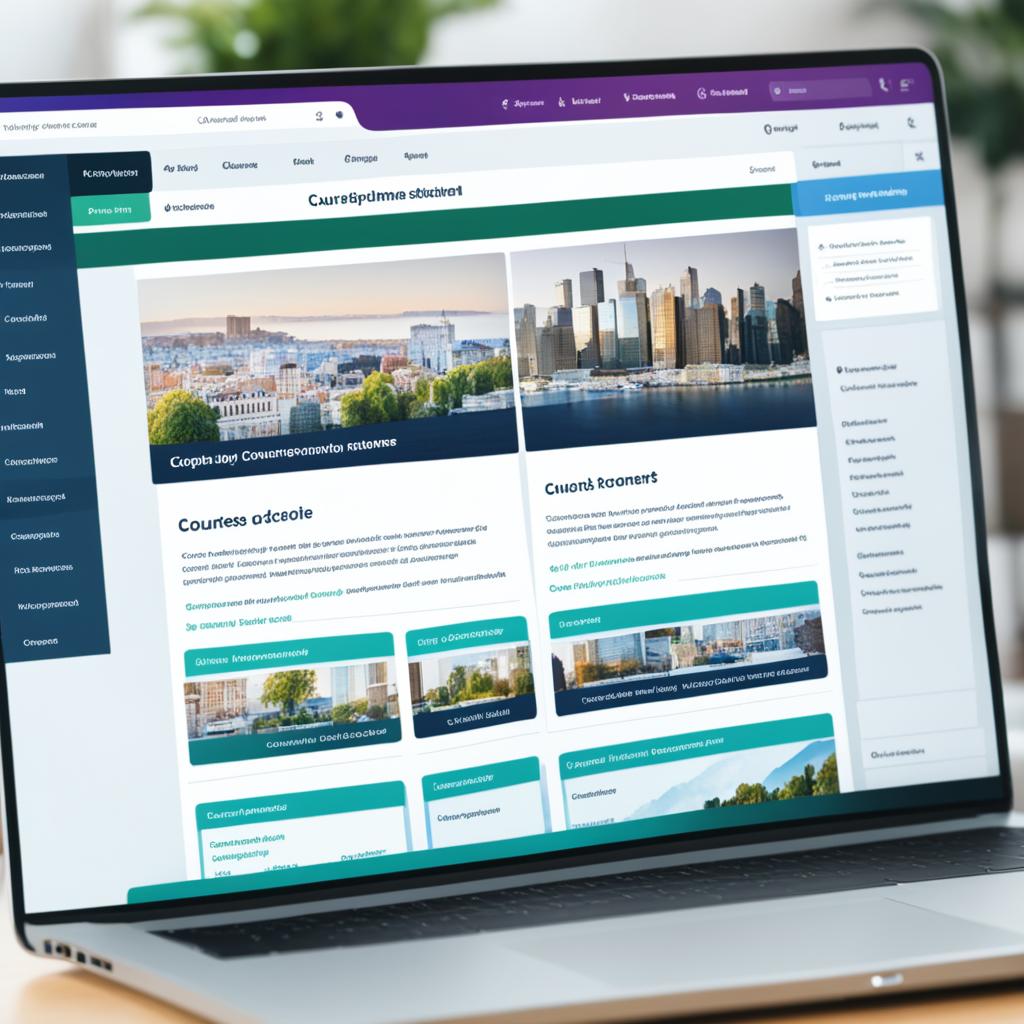Building an online course is a valuable way to showcase your expertise, reach a global audience, and generate income. In this article, I will guide you through a comprehensive process on how to create an online course in your area of expertise. Whether you are an industry professional, a thought leader, or an entrepreneur, creating an online course can provide incredible opportunities for growth and impact. Let’s dive in and discover how you can turn your expertise into a successful online course.
Key Takeaways:
- Select a topic that aligns with your expertise and passion.
- Conduct market research to validate the demand for your course idea.
- Create compelling learning outcomes that resonate with your target audience.
- Structure your course effectively to offer a seamless learning experience.
- Produce high-quality course content to engage and educate your students.
Why Creating an Online Course is Essential for Experts and Thought Leaders
In today’s digital age, building an online course has become an essential tool for entrepreneurs, experts, and thought leaders. It allows me to demonstrate my expertise, build credibility, and reach a global audience. By creating an online course, I can leverage my industry knowledge to generate income and make a lasting impact.
Online courses provide a platform for experts like myself to share valuable insights, practical skills, and specialized knowledge in a structured and accessible format. These courses not only showcase my expertise but also establish me as a trusted authority in my field.
By offering an online course, I can attract a global audience eager to learn from someone who has hands-on experience and a deep understanding of the subject matter. The online format provides flexibility and convenience, allowing students to access the course materials at their own pace and from anywhere in the world.
Moreover, creating an online course enables me to monetize my expertise. By packaging my knowledge into a comprehensive learning experience, I can generate income from students who are willing to invest in their personal and professional growth.
“Building an online course has transformed the way I share my expertise. It has allowed me to reach a wider audience, establish my authority, and create a sustainable income stream.”
The online education industry is booming, with millions of learners actively seeking expert-led courses to enhance their skills and knowledge. By tapping into this growing market, I can position myself as a thought leader and make a significant impact on the lives and careers of my students.
In the next section, I will explore the 10 stages of creating an online course, providing expert advice and guidance on each step of the process. From selecting the perfect course topic to launching and marketing the course successfully, I will cover everything you need to know to create a compelling and profitable online course.
The Benefits of Creating an Online Course
| Benefits | Description |
|---|---|
| 1. Demonstrated expertise | Building an online course showcases my expertise in a specific area, establishing credibility and authority. |
| 2. Global reach | By creating an online course, I can reach a global audience and impact lives beyond geographical boundaries. |
| 3. Monetization | Online courses provide a source of income through enrollment fees, allowing me to monetize my expertise. |
| 4. Thought leadership | An online course positions me as a thought leader in my industry, attracting opportunities for collaborations and speaking engagements. |
| 5. Flexibility | Online courses offer flexibility for both instructors and students, allowing them to learn at their own pace and convenience. |
| 6. Impactful teaching | Creating an online course enables me to make a lasting impact on the lives and careers of my students. |
The 10 Stages of Creating an Online Course
Creating an online course is an exciting journey that requires a systematic approach. To help you navigate this process effectively and maximize your chances of success, I will outline the 10 essential stages involved in creating an expert-led e-learning experience.
1. Selecting the Perfect Course Topic
Choosing the right course topic is the foundation of your online course. It should align with your expertise and passion while also fulfilling the needs and interests of your target audience. By selecting a compelling and relevant topic, you can capture the attention of eager learners.
2. Ensuring Market Demand
Before investing time and effort into creating your online course, it’s critical to validate its demand in the market. Conduct thorough research to identify your target audience’s needs, understand their pain points, and assess the competition. By addressing a viable market demand, your course stands a better chance of success.
3. Creating Compelling Learning Outcomes
Compelling learning outcomes are the key to engaging your learners and ensuring they achieve tangible results. Clearly define the desired knowledge and skills your students will acquire upon completing the course. By setting measurable and impactful learning outcomes, you can guide your learners towards success.
4. Structuring Your Course Effectively
The structure of your course determines its flow and organization. Divide your content into logical modules and lessons, making it easy for learners to navigate and comprehend. Consider the best delivery methods for each lesson, incorporating a variety of engaging multimedia elements to enhance the learning experience.
5. Designing Engaging Course Materials
To captivate your audience, it’s crucial to produce high-quality course materials. Develop visually appealing slides, record clear and professional videos, and create interactive quizzes and assessments. By delivering engaging and informative content, you can keep your learners motivated and eager to continue their educational journey.
6. Selecting the Right Course Platform
Choosing the right course platform is instrumental in delivering a seamless learning experience to your students. Research and compare various e-learning platforms, considering factors such as user-friendliness, customization options, and integrated features. Select a platform that aligns with your needs and provides a user-friendly interface for both you and your learners.
7. Implementing Effective Course Marketing
Once your course is ready, it’s time to spread the word and attract students. Develop a comprehensive marketing strategy that includes creating a compelling sales page, utilizing social media platforms, and leveraging email marketing campaigns. By effectively promoting your course, you can reach a wider audience and maximize enrollment.
8. Launching Your Course Successfully
Launching your online course is an exciting milestone. Set a specific launch date and build anticipation by offering limited-time promotions or bonuses. Ensure all course materials are fully prepared and tested before the launch. By executing a successful launch plan, you can create buzz and generate initial momentum for your course.
9. Building a Supportive Community
Encouraging student engagement and fostering a supportive community is crucial for the long-term success of your online course. Create a dedicated space for learners to interact, ask questions, and provide feedback. Engage with your students regularly, offering guidance and addressing their concerns. By building a community, you can enhance the overall learning experience and cultivate loyal students.
10. Gathering and Incorporating Feedback
Your journey doesn’t end with the launch of your course – it’s an ongoing process of improvement. Actively seek feedback from your learners through surveys, testimonials, and discussions. Analyze the feedback and make necessary adjustments to enhance the quality of your course continually.
By following these 10 stages of creating an online course, you can establish yourself as a learning expert and provide a valuable e-learning experience for your students. It may feel overwhelming at first, but with proper planning, dedication, and the right guidance, you can create an exceptional course that leaves a lasting impact on your learners’ lives.
Choosing the Perfect Course Topic
When embarking on the journey of creating an online course, the first and most crucial step is selecting the perfect course topic. This decision lays the foundation for the success of your online education venture. As an expert in your field, you possess unique knowledge, expertise, and insights that can benefit others. By sharing your expertise through a well-chosen course topic, you can position yourself as a leader in your industry and attract a targeted audience eager to learn from you.
So, how do you go about choosing the perfect course topic? It starts with identifying an area in which you have a deep understanding and passion. What is your area of expertise? What topics excite you and ignite your enthusiasm? By aligning your course topic with your passions and expertise, you can infuse your teaching with genuine enthusiasm, making the learning experience engaging and impactful.
However, it is not enough to choose a topic based solely on your expertise and passion. You also need to ensure that there is market demand for your chosen topic. Conducting market research allows you to gauge if there is a target audience actively seeking knowledge in your area of expertise. For instance, if you’re an expert in virtual training mastery, you might research keywords related to virtual training or online education guidance to assess the demand and competition in the market.
Remember, the ideal course topic is the intersection of your expertise, passion, and market demand. By carefully considering these factors, you can choose a course topic that not only showcases your knowledge but also attracts a motivated audience eager to learn from you.
“Choose a course topic that aligns with your expertise, passion, and market demand. This strategic combination will position you as an expert and help attract a motivated audience.”
Benefits of Choosing the Right Course Topic:
- Establish yourself as an expert in your field
- Attract a targeted audience interested in your knowledge and skills
- Create engaging and impactful learning experiences
- Stand out in a competitive online education landscape
- Generate valuable income by sharing your expertise
With a well-chosen course topic, you lay the groundwork for a successful online course that resonates with your audience and delivers value. Now that you’ve identified the perfect topic, it’s time to dive into the next stages of creating your online course, such as conducting market research and validating your course idea. Stay tuned!
Conducting Market Research and Validating Your Course Idea
Before diving into the creation of your online course, it is crucial to conduct market research and validate your course idea. By understanding your target audience, identifying their learning gaps, and assessing the demand for your course in the market, you can ensure that your course meets the needs and interests of potential students, increasing its chances of success.
To effectively conduct market research and validate your course idea, consider the following:
- Define your target audience: Identify the specific group of individuals who would benefit the most from your expertise. Understanding their demographics, interests, and existing knowledge will help you tailor your course to their needs.
- Identify learning gaps: Determine the specific areas or skills that your target audience is seeking to learn or improve upon. This will enable you to develop course content that addresses these gaps effectively.
- Analyze competition: Research existing online courses within your niche to identify what is already available. This will help you differentiate your course and offer unique value to your potential students.
- Assess market demand: Evaluate the demand for courses similar to yours by exploring forums, social media, and industry publications. Look for trends, discussions, and keywords that indicate a strong interest in your topic.
- Collect feedback: Seek input from your target audience through surveys, interviews, or focus groups. Their feedback can provide valuable insights that will shape the content and structure of your course.
By conducting thorough market research and validating your course idea, you can confidently move forward with creating an online course that caters to the needs of your target audience, maximizing its potential for success.
Designing Compelling Learning Outcomes
When creating an expert-led e-learning course, designing compelling learning outcomes is a crucial step. Learning outcomes serve as a guide for course development and define what students will achieve by completing the course. By carefully crafting learning outcomes, you can ensure that your course aligns with the course topic and addresses the needs of your target audience.
Effective learning outcomes have several key characteristics:
- Specific: Learning outcomes should clearly outline what students will be able to do or understand after completing the course. By being specific, you provide a clear direction for your students’ learning journey.
- Measurable: It is essential to create learning outcomes that can be measured or assessed. This allows both the learners and instructors to track progress and determine if the desired outcomes have been achieved.
- Relevant: Design learning outcomes that are relevant to the course topic and the needs and interests of your target audience. By making the outcomes relevant, you increase students’ motivation and engagement.
- Challenging: Learning outcomes should be challenging enough to stretch students’ capabilities and encourage growth. By setting ambitious goals, you inspire learners to push their boundaries and achieve more.
By incorporating these elements into your learning outcomes, you can create an engaging and impactful expert-led e-learning experience. Keep in mind that learning outcomes should be realistic and attainable while providing a meaningful learning experience for your students.
Inspiring quote: “Learning outcomes are the compass that guides students toward their educational destination.” – [Influencer]
When designing your learning outcomes, consider incorporating action verbs that vividly describe the skills or knowledge students will gain. Examples of action verbs to use in your outcomes include:
- Apply
- Analyze
- Create
- Evaluate
- Generate
- Implement
- Interpret
- Reflect
- Synthesize
Using these action verbs helps set clear expectations and provides a roadmap for students to follow throughout the course.
Example of Compelling Learning Outcomes:
| Module | Learning Outcomes |
|---|---|
| Module 1: Introduction to [Course Topic] |
|
| Module 2: [Specific Skill/Concept] |
|
| Module 3: [Another Skill/Concept] |
|
By designing compelling learning outcomes that are specific, measurable, relevant, and challenging, you can create an expert-led e-learning course that captures the interest and drives the success of your students.
Structuring Your Course for Optimal Learning
The structure of your online course is a critical factor in ensuring its effectiveness and engagement. By carefully organizing your course content, you can create a seamless learning experience for your students and help them achieve their desired outcomes. Here’s how you can structure your course for optimal learning:
1. Organize your content into modules and lessons
Divide your course material into logical modules and lessons. This enables your students to navigate through the content easily and progress through the course at their own pace. Each module should cover a specific topic, while lessons within the modules should provide focused learning objectives and information.
2. Determine engaging delivery methods
Take into consideration the nature of your course content and choose delivery methods that will engage your students effectively. This could include a combination of text-based lessons, videos, interactive quizzes, and practical exercises. By employing different delivery methods, you cater to different learning preferences and enhance the overall learning experience.
3. Create a coherent flow of information
Ensure that the information in your course flows logically from one module to the next and from one lesson to another. This allows students to build upon their knowledge and easily understand the connections between different concepts. Consider using visual aids, summaries, and review exercises to reinforce key points and facilitate comprehension.
“The structure of an online course can greatly impact the learning experience. By organizing the content thoughtfully and creating a logical flow, instructors can ensure that students stay engaged and grasp the material more effectively.”
Creating a well-structured online course is not only beneficial for your students but also for you as an instructor. It allows you to plan your course more efficiently, facilitates updates and revisions, and enhances the overall quality of your teaching. Take the time to carefully structure your course, and you’ll provide your students with a valuable and engaging learning journey.
Producing High-Quality Course Content
Producing high-quality course content is essential for creating a valuable learning experience. As an online educator, I understand the importance of delivering content that engages and inspires my students. From filming to editing, every step of the content creation process plays a significant role in capturing and maintaining their attention.
When it comes to filming your course materials, consider the following tips:
- Invest in a good quality camera or webcam to ensure clear and sharp video recordings.
- Choose a quiet and well-lit location for filming to enhance the visual and audio quality of your content.
- Use a tripod or stable surface to eliminate shaky footage and ensure a professional look.
Once you have your raw footage, it’s time to edit and polish it:
- Select a reliable video editing software that suits your needs and level of expertise.
- Trim unnecessary footage and remove any mistakes or awkward pauses to maintain a smooth flow of information.
- Add professional transitions and effects to enhance the visual appeal and keep your students engaged.
I believe that by dedicating time and effort to produce high-quality course content, I can provide my students with a valuable learning experience that exceeds their expectations. Quality content not only keeps students motivated but also ensures that they can easily understand and apply the knowledge and skills taught in the course.
Tips for Captivating Your Audience
To captivate your audience and deliver knowledge effectively, consider incorporating the following strategies into your course content:
- Use visuals and graphics to illustrate complex concepts and reinforce key points. Visual aids can significantly enhance students’ understanding and retention of the material.
- Break down complex topics into digestible chunks by dividing them into smaller lessons or modules. This allows students to grasp the content at their own pace and prevents overwhelming them.
- Include real-life examples and case studies to make the content relatable and showcase practical applications. This helps students connect theory to real-world scenarios and reinforces their learning.
| Advantages of High-Quality Course Content | Tips for Creating High-Quality Content |
|---|---|
| 1. Enhances student engagement and motivation | 1. Invest in good quality recording equipment |
| 2. Improves understanding and retention of knowledge | 2. Choose a quiet and well-lit filming location |
| 3. Establishes credibility and professionalism | 3. Trim unnecessary footage and mistakes during editing |
| 4. Encourages positive student reviews and recommendations | 4. Add professional transitions and effects in post-production |
Remember, the quality of your course content reflects your expertise and your commitment to offering the best learning experience to your students. By investing time, effort, and resources into producing high-quality content, you can provide a virtual training mastery that leaves a lasting impression on your audience.
Setting Up Your Online School
When it comes to creating and launching your online school, there are several key components that you need to consider. By taking the time to choose the right course platform, design a visually appealing website, and configure the necessary features, you can create a professional and engaging environment for your students.
Choosing the Right Course Platform
One of the first steps in setting up your online school is selecting the right course platform. This is the foundation of your entire online learning experience, so it’s essential to choose a platform that aligns with your goals and requirements.
Consider factors such as ease of use, customization options, payment processing capabilities, and integrations with other tools you may need. Popular course platforms like Teachable, Thinkific, and Kajabi offer a range of features and functionalities to help you create and manage your online courses effectively.
Designing an Attractive and User-Friendly Website
Your online school website serves as the front door to your courses and brand. It’s crucial to create a website that is visually appealing, user-friendly, and reflects your expertise and branding.
Use a clean and professional design, with a clear navigation menu that makes it easy for students to access your courses. Incorporate high-quality images, videos, and testimonials to showcase the value and credibility of your courses. Additionally, optimize your website for mobile devices to ensure a seamless user experience across different devices.
Configuring the Necessary Features
Once you have chosen your course platform and designed your website, it’s time to configure the necessary features that will enhance the learning experience for your students.
Some essential features to consider include:
- A user-friendly course dashboard where students can easily navigate through your course material.
- A secure login and registration system to protect your course content and ensure only enrolled students have access.
- Intuitive progress tracking tools that allow students to see their progress, completion rates, and achievements.
- Discussion forums or community spaces where students can interact with each other and ask questions.
- Integration with popular email marketing platforms to communicate with your students effectively.
By configuring these features, you can create an engaging and interactive learning environment that keeps your students motivated and fosters a sense of community.

| Benefits of Setting Up Your Online School | Considerations |
|---|---|
| Reach a global audience and make your expertise accessible to anyone with internet access. | Choose a course platform that offers reliable customer support to assist you whenever you encounter technical issues. |
| Generate revenue by monetizing your knowledge and skills through course sales. | Ensure that your website is optimized for search engines to attract organic traffic and increase your online visibility. |
| Build a reputable brand in your industry by becoming a recognized expert and thought leader. | Regularly update your course content to provide value to your existing students and attract new ones. |
| Offer flexible learning options that fit the busy schedules of your target audience. | Implement effective marketing strategies to promote your online school and courses to your target audience. |
Setting up your online school is an exciting step towards sharing your expertise with a global audience. By choosing the right course platform, designing an attractive website, and configuring the necessary features, you can create a professional and engaging online learning environment that attracts students and helps them achieve their learning goals.
Establishing Pricing Structure for Your Course
When it comes to monetizing your expertise through an online course, establishing a well-thought-out pricing structure is essential. Determining the right price for your course requires careful consideration of various factors, including the value and uniqueness of your content, the market demand, and the willingness of your target audience to pay. In this section, I will provide you with expert tips on how to set the optimal pricing structure for your digital course, maximizing its profitability while remaining competitive.
Here are some key considerations to keep in mind:
- The value and uniqueness of your course: Assess the value that your course provides to your learners. Consider the knowledge, skills, and expertise you are sharing, as well as any unique features or offerings that set your course apart from others in the market.
- The market demand: Research the market to identify the demand for courses in your niche. Analyze competitors’ pricing models and evaluate how your course aligns with their offerings in terms of quality and content.
- Target audience’s willingness to pay: Understand your target audience’s financial capabilities and expectations. Conduct surveys or gather feedback to gauge their willingness to invest in online learning experiences.
By strategically analyzing these factors, you can arrive at a price point that reflects the value of your course while appealing to your target audience. It’s important to strike a balance where your course is perceived as valuable and worth the investment, yet remains accessible to your intended learners.
“Setting the right price for your course is a delicate balance between meeting your financial goals and ensuring your audience sees the value in what you offer.” – Emily Johnson, Course Creation Expert
Consider implementing tiered pricing models to cater to different segments of your target audience. This can include offering basic, standard, and premium packages with varying levels of content and support. By providing options, you can accommodate learners with diverse budgets and preferences, increasing your course’s appeal and potential customer base.
Case Study: Pricing Tiers for a Language Learning Course
| Tier | Features | Price |
|---|---|---|
| Basic | Access to core learning materials and exercises | $49 |
| Standard | Includes basic features + weekly live Q&A sessions | $79 |
| Premium | Includes standard features + personalized feedback on assignments | $129 |
In this pricing table example, the language learning course offers three tiers catering to learners with different needs and budgets. The basic tier provides core learning materials, while the standard tier offers additional interactive elements. The premium tier includes personalized feedback to enhance the learning experience. By offering these pricing options, the course creator can attract a broader range of learners and maximize revenue potential.
Remember to monitor and evaluate your pricing strategy periodically. As your course gains traction and evolves, you may need to make adjustments to stay competitive and meet changing market demands. By staying attuned to your target audience’s preferences and regularly assessing the value you provide, you can ensure your pricing structure remains relevant and effective over time.
Next up, we’ll dive into the final section and explore how to successfully launch and market your online course, leveraging various strategies and channels to maximize its visibility and enrollment.
Launching and Marketing Your Course for Success
Launching and marketing your online course effectively is vital to its success. It involves creating a compelling sales page, implementing effective marketing strategies, and leveraging various promotional channels. In this section, I will share expert tips and techniques to help you successfully launch and market your course, ensuring maximum visibility and enrollment.
Creating a Compelling Sales Page
One of the first steps in effectively launching your course is creating a compelling sales page. This page serves as the gateway for potential students to learn more about your course and make a purchase decision. Here are some key elements to consider when designing your sales page:
- Clear and concise course description highlighting the benefits and outcomes
- Showcasing your expertise and credentials
- Including testimonials or success stories from previous students
- A persuasive call-to-action that encourages visitors to enroll
Implementing Effective Marketing Strategies
Marketing is crucial for attracting and reaching your target audience. Here are some effective strategies to promote your online course:
- Content Marketing: Create valuable content related to your course topic through blog posts, videos, or social media posts. This will establish your credibility and attract potential students.
- Email Marketing: Build an email list and send regular newsletters and updates about your course. Offer exclusive content or limited-time promotions to incentivize enrollment.
- Social Media Advertising: Utilize targeted advertising on platforms like Facebook, Instagram, or LinkedIn to reach your ideal audience. Craft compelling ad copy and visuals to capture attention.
- Influencer Partnerships: Collaborate with influencers or experts in your industry to promote your course to their engaged audience. This can help expand your reach and credibility.
Leveraging Various Promotional Channels
To maximize the visibility of your course, it’s essential to leverage various promotional channels. Here are some channels you can utilize:
- Utilize your website: Prominently feature your course on your website’s homepage or create a dedicated landing page.
- Participate in relevant online communities: Engage in forums, groups, and communities where your target audience gathers. Share valuable insights and mention your course when appropriate.
- Collaborate with industry partners: Reach out to other experts or businesses in your industry for potential collaborations or joint promotions.
Remember, effective course launch and marketing strategies require consistent effort and ongoing optimization. Continuously monitor and analyze the performance of your sales page, marketing campaigns, and promotional channels to make adjustments and maximize your course’s success.
| Benefits of Effective Launch and Marketing | Actions |
|---|---|
| Increased visibility and reach | Create a compelling sales page |
| Higher enrollment numbers | Implement effective marketing strategies |
| Enhanced credibility and authority | Leverage various promotional channels |
| Targeted audience engagement | Continuously optimize and monitor your efforts |
Building Your Community and Collecting Feedback
Building a strong community around your online course is essential for its long-term success. By fostering engagement, encouraging student interaction, and collecting feedback, you can continuously improve your course and provide a valuable learning experience. In this section, I will share some expert tips and strategies for building an active and supportive community, as well as gathering valuable feedback from your students.
Fostering Engagement and Encouraging Interaction
One of the keys to building a thriving community is to create opportunities for engagement and interaction among your students. Here are some effective ways to foster engagement:
- Facilitate discussions and forum participation: Provide a dedicated space for students to connect, ask questions, and share insights. Encourage active participation and moderate the discussions to ensure a respectful and inclusive environment.
- Organize live Q&A sessions: Schedule regular live sessions where students can join you for a real-time conversation. This allows for direct interaction and provides a personal touch to your online course.
- Assign group projects or exercises: Encourage collaboration by assigning group projects or exercises that require students to work together. This fosters a sense of community and allows students to learn from one another.
Collecting Feedback to Improve Your Course
Gathering feedback from your students is invaluable in improving the quality of your course and meeting their needs. Here are some effective ways to collect feedback:
- Surveys and questionnaires: Create surveys or questionnaires to gather structured feedback from your students. Ask about their learning experience, course content, and any suggestions for improvement.
- Feedback forms or suggestion boxes: Provide a dedicated platform for students to submit feedback or suggestions. This can be in the form of an online form or a suggestion box within your course platform.
- One-on-one conversations: Engage in one-on-one conversations with your students to gather their individual feedback. This can be done through email, video calls, or dedicated office hours.
Remember, feedback is a valuable tool for continuous improvement. Embrace constructive criticism and use it as an opportunity to enhance your course and provide an exceptional learning experience.
Building a community and collecting feedback go hand in hand. By fostering engagement and encouraging interaction, you create a vibrant learning community where students can support and learn from one another. Additionally, gathering feedback allows you to address any gaps or areas for improvement, ensuring that your online course remains valuable and relevant.
Conclusion
Creating an online course in your area of expertise is a transformative journey that empowers you to share your knowledge, earn income, and leave a lasting impact. By following the step-by-step guide provided in this article, you can confidently navigate the process and successfully launch your expert-led e-learning experience.
Key to your online course success is selecting the perfect course topic, conducting thorough market research, and designing compelling learning outcomes that resonate with your audience. Additionally, structuring your course effectively and implementing targeted marketing strategies will help you reach and engage your target audience.
Remember, building an effective online course requires dedication and strategic planning. As you embark on this exciting path, stay committed to delivering high-quality content and continuously gathering feedback to enhance your course. By leveraging the power of e-learning, you can establish yourself as a respected expert in the online education industry.
FAQ
What are the benefits of creating an online course in my area of expertise?
How can I select the perfect topic for my online course?
Why is market research important before creating an online course?
How can I design compelling learning outcomes for my online course?
What should I consider when structuring my online course?
How can I produce high-quality course content for my online course?
What is involved in setting up my online school?
How can I determine the pricing structure for my online course?
What are some effective strategies for launching and marketing my online course?
How can I build a community around my online course?
Source Links
- https://www.shopify.com/blog/how-to-create-an-online-course
- https://www.thinkific.com/blog/10-steps-creating-successful-online-course/
- https://elearningindustry.com/secrets-to-plan-your-online-course-and-identify-your-area-of-expertise
Money posts:
 The Best Passive Income Ideas for Students (Little to No Investment) (2024)
The Best Passive Income Ideas for Students (Little to No Investment) (2024)
 10 Best Entry-Level Digital Marketing Jobs (2024)
10 Best Entry-Level Digital Marketing Jobs (2024)
 How to Become a Digital Marketer (2024 Guide)
How to Become a Digital Marketer (2024 Guide)
 How to Start a Digital Marketing Agency With No Experience
How to Start a Digital Marketing Agency With No Experience
 50 Easy Ways to Make Money in College (2024)
50 Easy Ways to Make Money in College (2024)
 Online Jobs for College Students
Online Jobs for College Students
 17 Best Ways to Teach English Online (2024)
17 Best Ways to Teach English Online (2024)
 Best Ways to Start Investing for College Students (2024)
Best Ways to Start Investing for College Students (2024)

